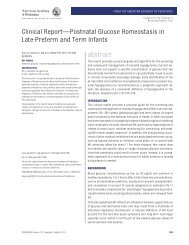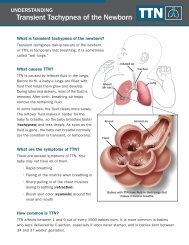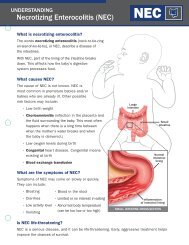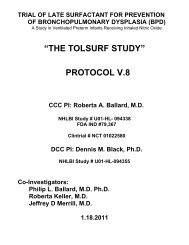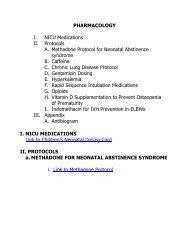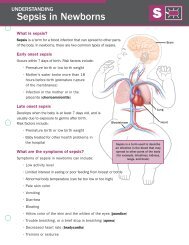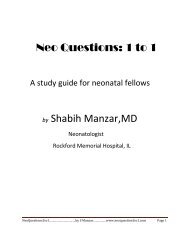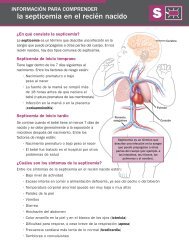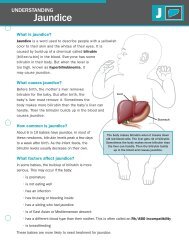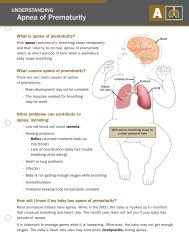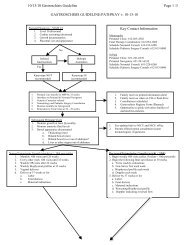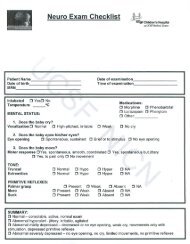genetics<strong>CHARGE</strong> <strong>and</strong> <strong>VATER</strong>/VACTERLangular concha (Fig. 2). Middle ear anomalies includeossicular malformations, an abnormal or absent ovalwindow, <strong>and</strong> absent stapedius muscle. Among the innerear anomalies are aplastic or hypoplastic semicircularcanals, <strong>and</strong> the Mondini defect (decreased number <strong>of</strong>turns to the cochlea) is present in up to 95% <strong>of</strong> affectedindividuals <strong>and</strong> can be detected by CT scan <strong>of</strong> the temporalbones. Temporal bone abnormalities also may bepresent. The combination <strong>of</strong> ossicular malformations <strong>and</strong>inner ear defects frequently results in a mixed (conductive<strong>and</strong> sensorineural) hearing loss that can range frommild to pr<strong>of</strong>ound.Although not described in the original acronym, cranialnerve (CN) anomalies also are common <strong>and</strong> now areincluded among the major diagnostic criteria (Table).Such anomalies usually are asymmetric <strong>and</strong> can involveCN I, resulting in hyposmia or anosmia (an absentor hypoplastic olfactory bulb is highly indicative <strong>of</strong><strong>CHARGE</strong>); CN V, resulting in the incoordination <strong>of</strong>sucking, chewing, <strong>and</strong> swallowing; CN VII, resulting infacial paralysis that is usually unilateral (Fig. 3); CN VIII,resulting in sensorineural hearing loss; <strong>and</strong> CN IX/X/XI, resulting in dysfunctional swallowing, gastroesophagealreflux, <strong>and</strong> velopharyngeal aspiration.A clinical diagnosis <strong>of</strong> <strong>CHARGE</strong> syndrome can bemade based on the major <strong>and</strong> minor diagnostic criteria(Table) defined by Blake <strong>and</strong> associates in 1998. Thepresence <strong>of</strong> all four major criteria (choanal atresia,coloboma, characteristic ears, <strong>and</strong> cranial nerve anomalies)or three major <strong>and</strong> three minor characteristics indicatesa diagnosis <strong>of</strong> <strong>CHARGE</strong> syndrome. The diagnosisshould be considered strongly in any neonate who exhibitsone <strong>of</strong> the major diagnostic criteria, <strong>and</strong> evaluation forabnormalities in other organ systems involved in<strong>CHARGE</strong> should be initiated.Figure 2. Hypoplastic lobule, prominent antihelix, <strong>and</strong> trangularconcha characteristic <strong>of</strong> the typical “<strong>CHARGE</strong> ear.”Genetic TestingIn 2004, Vissers <strong>and</strong> colleagues identified a molecularcause for <strong>CHARGE</strong> syndrome. The responsible gene isCHD7 (chromodomain helicase DNA-binding protein7); the encoded protein regulates gene expression byaltering chromatin structure <strong>and</strong> plays a critical role inembryogenesis. Clinical testing is currently available, <strong>and</strong>the mutation detection frequency is approximately 60%to 65%.Despite the availability <strong>of</strong> mutation analysis,<strong>CHARGE</strong> syndrome remains a clinical diagnosis. In theneonatal period, the presence <strong>of</strong> iris or retinal coloboma,choanal atresia, characteristic ears, hearing loss, facialnerve palsy, or congenital heart defects should alert thephysician to the possible diagnosis. The evaluations initiatedin the neonatal intensive care unit should includean ophthalmology examination, echocardiography, earnose-throatevaluation, renal ultrasonography, <strong>and</strong> hearingscreen. The most sensitive diagnostic study, whichhas implications for management, is a CT scan <strong>of</strong> thetemporal bones. Approximately 95% <strong>of</strong> affected patientshave abnormalities <strong>of</strong> the inner <strong>and</strong> middle ear, includingthe Mondini defect, aplasia or hypoplasia <strong>of</strong> the semicircularcanals, <strong>and</strong> ossicular malformations. A highresolutionkaryotype should be performed to rule out achromosomal abnormality as the cause <strong>of</strong> multiple malformations.CHD7 analysis may be helpful in cases wherethe diagnosis is not clear, especially if the family is interestedin prenatal diagnosis for future pregnancies. Insimplex cases, the recurrence risk for the parents is low,but prenatal testing can be <strong>of</strong>fered to the family if there isa known mutation to rule out the unlikely event <strong>of</strong>germline mosaicism. The individual who has <strong>CHARGE</strong>syndrome has a 50% risk <strong>of</strong> having an affected child witheach pregnancy.<strong>VATER</strong>/VACTERL AssociationIn contrast to <strong>CHARGE</strong> syndrome, <strong>VATER</strong> (orVACTERL) association does not have a known molecularcause. <strong>VATER</strong> association initially was described byQuan <strong>and</strong> Smith in 1973, <strong>and</strong> the acronym describes thecomponents: Vertebral defects, Anal atresia, Tracheo-Esophageal fistula with esophageal atresia, <strong>and</strong> Radial<strong>and</strong> Renal dysplasia. Kaufman (1973) <strong>and</strong> Nora <strong>and</strong>Nora (1975) subsequently added “C” for cardiac defects<strong>and</strong> “L” for limb defects to broaden the acronym toVACTERL.NeoReviews Vol.9 No.7 July 2008 e301Downloaded from http://neoreviews.aappublications.org by J Michael Coleman on August 12, 2010
genetics<strong>CHARGE</strong> <strong>and</strong> <strong>VATER</strong>/VACTERLTable. Diagnostic Criteria <strong>of</strong> <strong>CHARGE</strong> <strong>Syndrome</strong>Feature Manifestations FrequencyMajor Diagnostic Criteria (4 Cs)ColobomaChoanal Atresia/stenosisCranial Nerve DysfunctionCharacteristic Ear AnomaliesMinor Diagnostic CriteriaCardiovascular MalformationsColoboma <strong>of</strong> the retina, iris, choroid, <strong>and</strong> disc;microphthalmiaUnilateral or bilateral, membranous or bony, stenosis oratresiaOlfactory tract anomalies, unilateral or bilateral facial palsy,sensorineural hearing loss, velopharyngeal incoordinationOuter: Short, wide, hypoplastic lobule, prominent antihelix,triangular conchaMiddle: Ossicular malformationsInner: Aplastic or hypoplastic semicircular canals, MondinidefectTemporal bone abnormalities80% to 90%50% to 60%75% to 95%Most commonly conotruncal defects, atrioventricular canal 75% to 85%defects, <strong>and</strong> aortic arch abnormalitiesGenital HypoplasiaMales: Microphallus, cryptorchidism50% to 60%Females: Hypoplastic labiaBoth: Hypogonadotropic hypogonadismDevelopmental Delay Delayed motor milestones, delayed language, hypotonia 100%Growth DeficiencyShort stature (usually postnatal), occasional growth hormone 70% to 80%deficiencyOr<strong>of</strong>acial Cleft Cleft lippalate 15% to 20%Tracheoesophageal Fistula All types 15% to 20%Distinctive Facial FeaturesSquare face with broad prominent forehead, prominent nasalbridge <strong>and</strong> columella, flat midface70% to 80%Occasional AbnormalitiesRenal AnomaliesSpinal AnomaliesH<strong>and</strong> AnomaliesNeck/Shoulder AnomaliesGastrointestinalUnilateral renal agenesis, horseshoe kidney, hydronephrosis,renal hypoplasia, duplex kidney, vesicoureteral refluxScoliosis, kyphosis, osteoporosis, hemivertebraePolydactyly, altered palmar flexion creases, atypical splith<strong>and</strong>/split foot deformity, clinodactyly, camptodactyly,cutaneous syndactylyShort/webbed neck, Sprengel deformityOmphalocele, umbilical hernia90%Clinical FindingsVertebral defects that have been described in VACTERLassociation include hemivertebrae, congenital scoliosis,hypersegmentation defects, <strong>and</strong> sacral dysgenesis; thoracolumbarhemivertebrae have been reported most frequently.Anal atresia or stenosis requires prompt surgicalconsultation <strong>and</strong> intervention. A wide range <strong>of</strong> cardiacanomalies have been described in the VACTERL association,although septal defects appear to be most common.Tracheoesophageal fistula or esophageal atresiaoccurs in approximately 1 in 3,500 births <strong>and</strong> is associatedwith other anomalies in about 50% <strong>of</strong> cases. Renalanomalies include renal agenesis, ureteropelvic junctionobstruction, <strong>and</strong> severe reflux. Limb defects tend toinvolve the upper limbs more <strong>of</strong>ten than the lower limbs;with upper limb involvement, the radial bones are affectedmore frequently than the ulnar bones. Radialaplasia, deviation <strong>of</strong> the h<strong>and</strong>, absence <strong>of</strong> the thumb,hypoplastic <strong>and</strong> rudimentary thumb, <strong>and</strong> preaxial polydactylyhave been described.Individuals who have VACTERL association usuallydo not have dysmorphic facial features, abnormalities <strong>of</strong>growth, or mental deficiency. Therefore, VACTERL is adiagnosis <strong>of</strong> exclusion that should not be made until atleast 1 year <strong>of</strong> age, when growth <strong>and</strong> development can beconfirmed to be normal.The differential diagnosis in the newborn periodincludes <strong>CHARGE</strong> syndrome, 22q11 deletion syndrome,<strong>and</strong> Townes-Brocks syndrome. Infants who have<strong>CHARGE</strong> syndrome can have cardiac defects, tracheoesophagealfistula, vertebral anomalies, <strong>and</strong> renal anomalies.If the diagnosis <strong>of</strong> <strong>CHARGE</strong> syndrome is consid-e302 NeoReviews Vol.9 No.7 July 2008Downloaded from http://neoreviews.aappublications.org by J Michael Coleman on August 12, 2010



